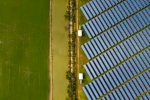
The infrastructure sector sits at a collision point of global disruptions, including shifts in capital availability, evolving social and environmental priorities, and rapid urbanisation. However, the emergence of COVID-19 introduces an altogether new set of challenges. The full impact of the pandemic will take years to play out. Yet in the near term, we believe it will affect governments’ ability to finance large-scale projects. Most countries faced a gap between infrastructure needs and financial resources before the pandemic hit; that gap is now larger as a result of it. Successful infrastructure delivery demands close alignment and collaboration among a wide range of participants, each with its own agenda and interest. The result? No single player acting alone can effect real change in the sector.
This is the third article in a series outlining the overarching forces that will shape the future of the infrastructure industry. The first looked at the immediate impact of COVID-19. The second considered developments in financing. And the fourth and final piece will address the need for resilience and sustainability.
Technology’s implications for infrastructure
Technology is revolutionising virtually every aspect of infrastructure. New developments span the entire industry, but three segments — power, ground-based urban transportation and air mobility — best illustrate the scope of the changes underway.
Tech-enabled changes in the delivery of capital projects
The construction industry has historically lagged behind other industries in embracing digital technology to improve operations and realise efficiencies. However, as recent PwC thought leadership has highlighted, top-performing organisations are now deploying tools to increase productivity, improve efficiency and safety, and reduce costs on major capital projects.
Key technologies for achieving these goals are growing rapidly in sophistication. California-based Skycatch is building drones that will use machine learning to generate a 3D model of a construction site, calculate the area and the volume of earth to be moved, plan the work, and even guide autonomous onsite construction vehicles. Additionally, drones are performing diagnostic functions such as inspecting difficult-to-access locations, including pipelines and sub-level infrastructure.
Technology is also improving the efficiency of project construction and delivery, for example, by using robotics to automate construction processes. Using the vast increase in bandwidth offered by 5G networks, advanced sensors can now be placed on transport infrastructure to collect real-time data that enables the creation of digital twins for projects underway. One successful application is the work by UK-based Sensat on the country’s HS2 high-speed rail link. Sensat is modelling the route of the proposed railway line to help monitor the project’s progress and ensure that workflows are efficient.
In parallel with these advances, the construction industry is starting to adopt data-driven technologies such as Building Information Modelling (BIM) and full-site data analysis to make budgeting and scheduling more accurate. Wearable devices for workers can collect data on worksites, creating huge opportunities to improve safety. One Australian construction company now provides its workers with smart helmets that monitor their temperature for heatstroke, keeping them healthier and reducing sick days. Other wearables applications include collision avoidance systems and smarter management of site access rights.
Data can also confer major benefits when construction is complete and projects become operational. Predictive analytics can generate forwards-looking insights about environmental conditions and structural performance to better anticipate maintenance requirements, thus reducing costs. Also, insights about how assets perform across their life cycle could unlock new and different service models for contractors, and help stakeholders invest in projects with a greater degree of confidence.
In addition, sophisticated digital infrastructure will become more important to the functioning of society as a whole, leading to ongoing investments for the foreseeable future. For example, high-speed communications infrastructure such as 5G is instrumental in the shift to more connected living, because without it the data simply won’t flow. In many countries, the speed and extent of wireless network coverage — together with the protocols governing wireless use — are major limitations on the ability to capitalise on data.
As dependency on IoT-enabled services and cloud computing grows, we will continue to see increases in the roll-out of enabling infrastructure such as data centres. There are also important interdependencies at play. For example, IoT relies heavily on the reduced latency brought by 5G and edge computing (essentially a distributed collection of micro data centres that process or store critical records locally).
The implications for infrastructure projects and stakeholders
As new technologies become more critical for the successful delivery of infrastructure assets and their subsequent operation, there will be profound implications for various stakeholders in at least three areas.
New business and financing models
Consider the ongoing outfitting of streetlights with sensors, wireless transmitters, EV charging stations, 5G transmitters, security cameras and other digital technologies, all of which open up new sources of revenue and additional means of financing projects. Though these are positive developments, the growing role of technological innovation is also making asset life cycles less predictable (causing a ripple effect along supply chains affecting service providers). And current contract structures, which last for decades and are highly rigid, are impeding the application of novel technology. The disparity between technology cycles and asset timelines will have significant consequences for contractors and financing organisations, which will need shorter-term contracts and a more flexible approach to financing. Similarly, projects will require open-ended approaches to create business cases that allow and encourage innovation.
Legacy assets
The industry will need to address the way that evolving technology makes some legacy assets obsolete. For investors seeking long-term, predictable revenues, infrastructure’s need for more adaptable and fluid business cases is problematic. If investors target, say, battery storage, they need to assess whether the underlying technology is likely to change in the next several years and make existing systems obsolete.
The additional risk of obsolescence means that companies and investors need the capabilities and expertise to determine which technology trends will dominate specific asset types. They must also consider the management of legacy investments — and the related repayment obligations — when new technologies are introduced that threaten to undermine the original investment assumptions by reducing demand for the asset (or even stimulating demand for new services based on it). Because technology forecasting is becoming so critical, many infrastructure businesses are investing in or acquiring technology start-ups to bring this expertise in-house.
Cybersecurity and data privacy risks
Infrastructure assets, especially critical infrastructure such as power plants, have always been vulnerable to physical damage. Now, these assets are controlled by cloud-based technologies, which introduces the risk of cyber threats. In the transport sector, North Korea reportedly tried to hack South Korea’s rail transit system, and criminals have used ransomware to shut down metro operations in Germany and San Francisco. In energy, Ukraine’s power grid was the target of a cyberattack in 2015 that left nearly a quarter of a million people without electricity. And in PwC’s latest Global CEO Survey, CEOs from transport and power companies ranked cyber risk as a top concern.
At the same time, data privacy and ownership is a growing issue, particularly in relation to the development of smart cities, in which many of the digital partners are commercial technology companies and consumers are concerned about balancing private profit and the public good. It’s already become a key issue for projects such as the Sidewalk Labs smart city development in Toronto. Overall, it’s clear that cyber risk should be placed front and centre when cities consider the digitisation of operational infrastructure, to help create a layer of resilience that will be crucial in delivering a safe, connected infrastructure environment in the future.
Alignment among stakeholders
A number of other elements must also be in place if future projects are to realise the full benefits technology can offer. Given the need to address and reconcile a wide variety of stakeholder interests — including those of infrastructure planners, users, developers and investors — careful coordination and balancing of objectives will be essential. Also, the ability to drive large-scale innovation in projects will depend on conducive regulation, political will and clear legal frameworks. Such is the pace of technological change, however, that legislators and regulators are struggling to keep up. And public entities will need to reassess their procurement processes to integrate technology, determine how its benefits will be captured and measured, and encourage the innovation required to increase the pace of technological progress in infrastructure.
Infrastructure technology in emerging economies
Even as developed economies capture the benefits of infrastructure technology, emerging countries have struggled to realise these same advantages, largely due to weak digital foundations and poor adoption rates. This is a missed opportunity, especially because the potential savings generated through technology could determine whether a project goes forwards or not.
Of course, working in regions with less advanced technology can add complexity to infrastructure projects. Yet some countries with less legacy infrastructure and leaner, less bureaucratic governments may be better positioned than more developed countries to take advantage of technology innovation and accelerate their digitisation journey. In that way, they can leapfrog over more advanced countries.
To do so, procurement processes must be transparent and create the right incentives for the application of new technologies. Governments must also develop supportive regulations to manage use. And, critically, governments can seek incremental benefits rather than trying to completely disrupt established processes. For many countries working to build core power, transport, water and urban infrastructure, the reality is that the traditional models of infrastructure financing — large capital investments repaid over long periods of time — are still attractive.
Finally, governments should stay abreast of what emerging market pioneers are doing. For example, India and some countries in the Middle East are already gaining a foothold in 5G and smart cities. These leaders will play an important role in setting the pace and direction for other emerging economies seeking to capitalise on such technologies in the future.
Reinvention through disruption
New and emerging technologies will be a huge part of the solution to today’s infrastructure challenges — improving transparency and efficiency; facilitating the transition to low-carbon, climate-resilient assets; and unlocking more sustainable business models. But, as in every industry, technology is a disruptive force, displacing traditional ways of planning, financing, delivering and maintaining infrastructure.
Incorporating technology into infrastructure projects will require a step change in policy focus, new financing solutions at both the consumer and portfolio levels, and more research and development to push faster technological innovation. These needs are now on the agenda of many infrastructure stakeholders. Over the next few years, we’ll see the increased focus on innovation in infrastructure bear fruit. And populations across the world will experience the benefits.
References
[1] International Renewable Energy Agency, “Renewables Account for Almost Three Quarters of New Capacity in 2019,” 6 April 2020:
https://www.irena.org/newsroom/pressreleases/2020/Apr/Renewables-Account-for-Almost-Three-Quarters-of-New-Capacity-in-2019.
[2] GlobalData, “Battery Energy Storage Market, Update 2019: Global Market Size, Competitive Landscape, and Key Country Analysis to 2023,” April 2019:
https://store.globaldata.com/report/gdpe1058emr--battery-energy-storage-market-update-2019-global-market-size-competitive-landscape-and-key-country-analysis-to-2023.
[3] Barbora Bondorová and Greg Archer, “Does sharing cars really reduce car use?” Transport & Environment, June 2017:
https://www.transportenvironment.org/sites/te/files/publications/Does-sharing-cars-really-reduce-car-use-June%202017.pdf. The average car sits unused for more than 90% of its service life, carries just one or two people, and costs about €6,500 each year to own and run.
[4] Gavin Braithwaite-Smith, “Electric cars still twice as expensive to buy as normal ones,” Motoring Research, 14 October 2019:
https://www.motoringresearch.com/car-news/electric-cars-twice-expensive-buy-normal-ones.
[5] Nora Manthey, “Paris may offer flying cabs by Airbus at 2024 Olympics,” electrive.com, 25 June 2019: https://www.electrive.com/2019/06/25/paris-may-offer-flying-cabs-by-airbus-at-2024-olympics.
In the previous article in this series, we focussed on developments in financing. In the next and final article, we focus on another important global force shaping infrastructure: sustainability.
Contact us

Global Capital Projects and Infrastructure Leader, PwC United Kingdom
Tel: +44 7764 235 239



















